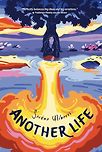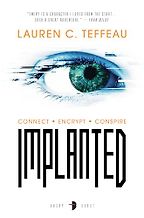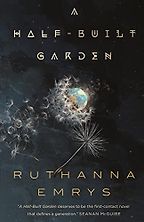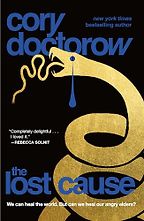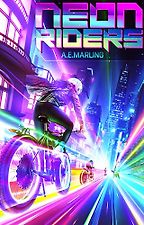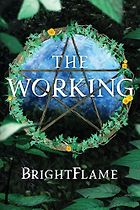What is solarpunk?
Solarpunk is a movement of artists, writers and activists engaged in the creative act of imagining more just and sustainable futures. As a genre of fiction, it’s a combination of technological science fiction and sociological science fiction: it’s looking at the technological innovations that can help us fight climate change, like renewable energies, but also the social and economic changes that can help us move toward true sustainability, since focusing only on the technological aspect can still lead to many injustices and greenwashing. So both the technological and the social-economic pieces are crucial to a solarpunk vision.
It is under the purview of the larger umbrella of climate fiction, but a lot of climate fiction focuses on the disasters and the dystopian outcomes of climate change and ecological collapse. Solarpunk does not ignore those issues, but it focuses on how we can make the world better: how we can thrive and adapt in the world that we are headed into. So rather than saying, “If this goes on, here’s the worst that can happen”, solarpunk asks, “If we change direction, what’s a better version that could happen?”.
Great! Please tell us about your first recommendation: Implanted, by Lauren C Teffeau.
Implanted is a far-future, climate fiction, solarpunk novel. It takes place in a domed city that was built to protect people from extreme weather caused by climate change. The domed city is kind of ecologically or economically stratified: the rich people live at the top, where there’s a lot of light, and the poor people live down at the bottom, where it’s dark and they don’t have access to light. This is far-future, and people are starting to think about emerging from the dome, going back out into the world and braving the new weather and the new world out there.
It’s a spy thriller. There’s somebody who’s smuggling information between the levels of the dome, and there’s intrigue and secrets and corruption. So it’s actually a very fast-paced, exciting spy story with the background of this ecological issue.
Aesthetically, it’s very solarpunk. Solarpunk tends to have an art nouveau aesthetic, with a lot of green and a lot of earthy tones, and you really get that aesthetic through this book. There’s a grassroots uprising that the characters are participating in, which is a very important part of solar punk. It’s never a top-down approach, never waiting around for governments and corporations to do the right thing. It’s about collective action from the people, from the bottom up. In Implanted, because of the way that the city is structured, it is physically from the bottom up. It’s really amazing.
Is solarpunk generally far future like this?
It can be far-future, or near-future, or anywhere in between. It’s looking at the trajectory that happens if we make changes. We always see that chart of rising temperatures, the track we’re on… Solarpunk looks at what happens if we make a change and the trajectory goes differently. We can look at stories at the far end of that, and say, “Once we get through all of this, what does that world look like?” Or we can look at any point along the way. Some of the other books that I am going to talk about are much more near-future.
If you’re looking at far-future, it can be more utopian – or utopian-ish! – where we have made it through all the struggle. Or you can look at the struggle along the way.
Let’s talk about your next choice – A Half-Built Garden by Ruthanna Emrys.
A Half-Built-Garden is also far-future, and it’s a first-contact alien story. The main character works for a watershed collective on the east coast of the US, and they make first contact with the alien – not a president, not the government, and not the military, but someone involved in a watershed collective, with her baby. It turns out that the aliens also have their babies with them, so the fact that the first human they contact has her child with her helps them to connect the two species: they have something in common, because they’re both caring for their young. So it looks at first contact in a very different way to most science fiction. We tend to think of first contact in a very colonial, patriarchal way, which mirrors first contact between Europeans and Native Americans, for example, or other colonial circumstances from our past where people clashed very violently. This book looks at it in a very different way.
This world is definitely not entirely utopian, but we have moved the trajectory of the world for the better, to a more sustainable and just society. The aliens come to Earth in this book because they heard that humans were destroying the planet, and they want to take the humans away and let Earth heal. The conflict comes from that: some people want to leave, and some people want to stay and continue helping to heal Earth, and not just abandon it – they want to be part of the ecology of Earth, because humans are part of the ecology. We’re not separate from it. The book is about that balance between human progress and innovation, and natural processes. It’s a very worthwhile read.
It’s a really interesting take on the notion of finding other habitable planets… You look at that ‘planet B’ idea in your own book, Another Life. There are so many ideas in there. Could you introduce the book and tell us about the ideas you wanted to foreground?
Another Life takes place in a solarpunk community, a peaceful eco-village in Death Valley, California. The conflict revolves around a new piece of technology that allows people to learn who they were in a previous lifetime. My character, Galacia, takes this test, which is essentially like a DNA test, and learns that she was a very horrible person in her past life, and someone who had directly affected many people in her community: a man named Thomas Ramsey.
Ramsey had proclaimed that there was a Planet B, and he could build the ship that would get them there. But it was all a scam; there was no Planet B. This scam led to a whole collapse within at least the United States – it probably extends beyond that, but certainly within the United States. Once Galacia knows this about herself, she has to grapple with that dark knowledge and see how the people around her react to it.
One of the things that I’m grappling with in this is the foundation of a violent past that we all have to live with. How do we build something better from a violent, unjust and unsustainable foundation? How do we take that and turn it into something better? The characters have created a small quasi-utopia. It’s definitely not the entire world, or even the entire country. It’s just a little piece of something better that makes a big difference to the people who live there.
I found that foundations question really interesting, really helpful to explore. I remember one passage about the impossibility of building on anything
that doesn’t have unjust beginnings at this point…
Yes, it’s almost impossible to get away from that. Once you start looking at the history of corporations, the history of anything, it’s very difficult to get away from that problematic beginning.
We’ve come to your third choice. Could you tell us about The Lost Cause, by Cory Doctorow?
The Lost Cause is very near-future, and I consider it solarpunk. Cory Doctorow has embraced the term solarpunk as well – some authors use the term, some of them have their own terms, but Cory Doctorow seems to be engaged with the solarpunk community. So it is very near future – around the 2040s or 50s – and it’s engaging with the politics of today.
The premise is that a Green New Deal has been struck, and we are moving toward renewable energies and climate change mitigation, but there is still a contingent of people who are clinging to the MAGA ideals. They’re still in climate denial, and they’re actively trying to sabotage the Green New Deal as it’s happening. It’s a very political book. It presents lots of climate solutions of many stripes, but it’s focused on the political division that has led to our lack of climate action.
It’s also very personal. The story is about a kid and his grandfather, who have completely opposite political ideas. It’s a very relatable situation these days, where often many of the people that we care about are just living in a completely different reality, and actively working against the things that we value.
What’s solarpunk about it is the focus on solutions. That’s the way that solarpunk can relieve climate anxiety and help move people toward action. Because when we focus on everything that can go wrong, on just the doom and gloom narrative, it seems like there’s nothing that we can do – when in fact there are lots of things that we can do, both on the large scale and on the small personal scale. I think The Lost Cause does a good job of showing both of those. It shows the big political and economic changes that need to happen, but also shows how these changes happen on the personal level, and how we can have these conversations with the people around us who don’t believe what is happening, or don’t share our values. It’s a good story, and it’s also a good toolbox that can give people tools to move past climate anxiety,
Is there a shared approach to politics among solarpunk fiction? I’ve seen a generally leftist, communitarian feel…
It definitely tends to be leftist. And there is a tendency toward anti-capitalism, or at least post-capitalism, which is a reaction to looking at the connections between late capitalism and the non-stop growth that has led to a lot of environmental destruction. So there’s a degrowth philosophy to a lot of solarpunk.
But within the solarpunk community, there are many people who look at things differently, and it is definitely not uniform. We have healthy debates online – the solarpunk community has really grown online, initially through Twitter and now places like Mastodon and Blue Sky, and Tumblr was a big part of the solarpunk community in the beginning. So it’s grown through these online conversations, and there are plenty of healthy debates and even just straight-up fights about the way that we should move toward a better future. Everyone comes at it from their own perspective, their own background. So you can’t really pin one political idea. It’s definitely to the left, but within that, there’s a lot of variation, and I think that’s good. There is no one way that we can solve climate change. It is not one big solution, it’s a thousand smaller solutions working together. I think that’s true politically, as well as socially, economically, and technologically.
Let’s discuss your fourth choice – the only magic-inflected book on the list. Please tell us about The Working by BrightFlame.
This is a wonderful book. The characters are modern-day witches, and they’re all part of a coven. The story takes place around a fracking protest – there’s a new fracking pipeline that they’re trying to put in, and it goes across one of these characters’ land. So they’re trying to prevent the fracking pipeline, and at the same time, they’re battling a larger conflict that they learn about on a spiritual plane. They’re in contact with some ancestral spirits who are warning them that what’s happening with this pipeline is not just an isolated incident, but has much larger implications for the whole world. So they’re using their collective action in the real world to fight, and they’re also using their collective action in the spiritual world to fight the larger fight.
It’s interesting to see magic and climate action in the same narrative.
When magic is incorporated into climate fiction, it runs the risk of being an unrealistic solution, a naïve “Everything will work out” story. This one really is pragmatic, and really personal. The magic that’s happening is manifest in reality as well – it’s not just, “Let’s cast a spell and hope everything works out.” This magic is very real, and it manifests in a way that feels real to the readers as well.
We’ve come to your last recommendation: A. E. Marling’s Neon Riders.
I just finished this one, and it’s really interesting. I would put it with Implanted, because it’s a cyberpunk-solarpunk crossover. Neon Riders is maybe mid-future, around the turn of the next century, in a version of San Francisco that is futuristic and very sustainable. The characters are part of a bike gang: they ride these electric bikes, and they’re connected to an augmented reality. The term ‘neon riders’ comes from the fact that when they’re plugged into this augmented reality, they can see the speed that they’re going through colour stripes in cyberspace, which creates a very cool cyberpunk visual. There’s an AI that doesn’t run the city, but helps the people in the city. So there’s a lot of those science fiction, cyberpunk-type tropes.
At the same time, it’s very community-focused. There are a lot of references to community gardens and rooftop gardens, and people growing their own food and making their own clothes. There’s a lot of focus on bike repair and the do-it-yourself movement, and repairing rather than replacing. And since San Francisco has a lot of fog, they’re harvesting water through fog harps that collect the dew and channel it into water that they can use. Things like that are just incorporated into the world-building throughout, so that it’s very clear that this is a sustainable community. But it’s not perfect – there’s a lot of conflict.
It’s a fast-paced story, very like a thriller in its pacing, but taking place in this solarpunk world. Like The Lost Cause, it’s dealing with current political divides in the United States. You have a character who comes from outside the city, and arrives with the intention of stealing something from the city and taking it back to their rural community. But once they get into the city and learn how things really work, and how it’s different from what they’ve been told, they decide they want to stay. It’s a very ride-or-die situation, where the new community that this person has found is not willing to let him be taken back to the community he doesn’t want to go back to. Half of the book is a big car chase: the big Humvee from outside the city being chased by these bikes with their neon colours. It’s very fun, and it’s very conflict-driven, which some solarpunk definitely is not. It will appeal to people who like that faster-paced story, but it really gives a sense of a different type of future that we could move toward, and a different type of community that we could create. And that’s what solarpunk is really trying to do: it’s trying to show something on the other side of the dark tunnel we’re looking into with climate change.
All your choices sound excellent. Are there any other solarpunk stand-outs you want to give a shout-out to?
I chose solarpunk novels for this because there aren’t very many. Most solarpunk is short fiction, and I think that happens because a thought experiment tends to do well in the short fiction form. So there’s a lot of solarpunk short fiction out there. Anthologies that I edited include Glass and Gardens and Multispecies Cities, where we collected a lot of different visions and created a polyphonic chorus of voices about what this future could look like. There’s also Solarpunk Magazine and DreamForge magazine, and plenty of others that are publishing these kinds of stories, these visions in short form. So there are lots of solarpunk stories available that can be read in one sitting.
Interview by Sylvia Bishop
August 23, 2025. Updated: August 25, 2025
Five Books aims to keep its book recommendations and interviews up to date. If you are the interviewee and would like to update your choice of books (or even just what you say about them) please email us at [email protected]
Five Books interviews are expensive to produce. If you've enjoyed this interview, please support us by donating a small amount.

